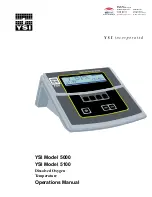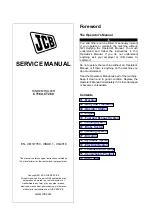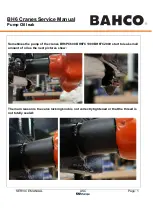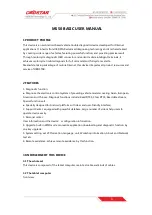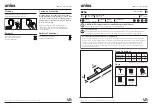
7
1.
Filling water
Remove the water basin
A
pulling it upwards and fill it by WARM WATER, only after having checked
the temperature (see running instructions).
Insert the filled basin
A
, placing it well on its base carefully.
2.
Putting on the nozzle
Put square jet on the handle
D
and press it until it engages. Put on guard sheet
C
.
3.
Quick filling of the tube system
Lowering the handle
D
under device level for a short time - before switching it on
E
the first time -
helps the quick filling of the tube system. Put handle
D
always back into the handle mounting of the
device to avoid automatic emptying of the water container and the tube system.
WATCH OUT! Do not fix over washbasin etc.!
FUNCTIONING
1.
Anamnesis and otoscopy
Otoscopy and questioning of the patient are necessary before the irrigation process.
In case of a tympanic-membrane perforation and/or an inflammatory process in the auditory canal an
irrigation is not advised.
In case of bad anamnesis the patient should be asked whether he/she has ever suffered from otorrhea,
whether water in the auditory canal has caused pains or whether former irrigations of the auditory
canal have already caused problems.
2.
Temperature of water
IMPORTANT! To avoid irritations the irrigation of the auditory canal has to be carried
out with warm water! water temperature has to be checked immediately before the irrigation
process!
To facilitate temperature checking, the device is supplied with the provided Temp.Test-Card.
Before filling, place the card under the water spurt. When temperature is correct (38° C) the card indicator
is green. Should it remain green for 2-3 seconds, the container can be filled. The lower levels are signalled
by blue colour while the higher levels are in brown colour.
After having filled the container, the card is to be hung on the back wall of the
A
basin, in order that the
indicator is under the water level. That way water temperature can be monitored anytime, which is
particularly useful if washing is not immediately carried out.
3.
Positioning of the irrigation jet
IMPORTANT! The irrigation jet has always to be directed towards the meatus walls! Do
never direct the irrigation jet towards the tympanic membrane!
Do never position the irrigation nozzle far into the auditory canal. Put it at the beginning
of the auditory canal towards the meatus walls.
The nozzle position must always grant the outlet of rinsing water!
4.
Adjusting the pressure
A general adjustment of the pressure
B
valid for every irrigation cannot be given as it depends, among
other things, on the prevailing situation in the auditory canal, the sensitivity of the patient and not least
the irrigation technique of the doctor.
IMPORTANT! Therefore it is absolutely necessary to get an impression of the range of the
pressure by means of the finger pulp test.
Put the irrigation jet towards the finger pulp of the middle finger with different pressure
levels.
In view of the higher sensitivity of the auditory canal with this test you get a good idea of how to adjust
the pressure
B
.
14
dies ist besonders günstig, wenn die Reinigung nicht sofort durchgeführt wird.
3.
Positionierung des Spülstrahles
WICHTIG! Der Spülstrahl muß immer auf die Gehörgangswand gerichtet werden!
Der Spülstrahl darf niemals in Richtung des Trommelfelles gerichtet werden.
Die Spulstrahldüse keinesfalls tief im Gehörgang positionieren, sondern etwa am Anfang
des Gehörganges an die Gehörgangswand richten.
Die Position der Düse muss immer den Ausgang des Spülwassers garantieren!
4.
Druckeinstellung
Eine generelle und für alle Spülungen gültige Druckeinstellung
B
kann nicht vorgegeben werden, da
diese u.a. von den jeweiligen Gegebenheiten ins Gehörgang, der Empfindsamkeit des Patienten und
nicht zuletzt von der Spültechnik des Arztes abhängig ist.
WICHTIG! Es ist deshalb unbedingt notwendig, sich vor einer Spülung einen Eindruck
über die zur Verfügung stehende Bandbreite des Spülstrahldruckes mittels Fingerbeerentest
zu verschaffen.
Hierbei richtet man den Spülstrahl bei den verschiedenen Druckstufen
B
auf die Fingerbeere des
Mittelfingers.
Der Test wird immer vor jeder Reinigung durchgeführt, da im Fall einer schlechten Wartung, die
Kalkablagerungen im Rohrsystem den Strahldruck erhöhen können.
Um eine Ohrspülung bei einer erwachsen Person durchzuführen, raten wir Niveau 2 für die Testspülung,
während Niveau 3-4 für die Hauptspülung.
Die Druckniveaus 5-6 sind ausschließlich zur Wartung vorgesehen!
5.
Test-Spülung
Mit einen fast drucklosen Spülstrahl wird eine kurze Testspülung durchgeführt. Damit wird die
Empfindsamkeit des Patienten getestet und dieser gleichzeitig an die Spülung gewöhnt.
Entsprechende Reaktionen des Patienten können hierbei z.B. auch auf Trommelfellperforationen
hinweisen, die mittels Otoskopie nicht zu sehen waren!
6.
Spülung
Die Pulsation des Spülstrahles bewirkt die Cerumenablösung auch bei einem relativ niedrigem
Spühlstrahldruck.
Normalerweise wird die Spülung mit einem Druckniveau 3-4 für maximal 15 Sekunden durchgeführt.
Den Druck während der Spülung nicht erhöhen!
Wenn der Patient sich nicht wohl fühl, sofort die Spülung unterbrechen!
Weiche bis mittelharte Cerumen können meist ohne lokale Behandlung mit aufweichenden Ohrentropfen
abgelöst werden. Bei komplettem Cerumenverschluß sollte vorher mit einen Haken eine kleine Öffnung
in die Cerumenplatte geritzt werden.
Eine Beobachtung des Auffangwassers kann Hinweise auf den Spülerfolg geben.
Nach der Cerumenentfernung sollte der Gehörgang getrocknet und desinfiziert werden.
INSTANDHALTUNG
Gehäuse, Handgriff
D
und Düsenteil nur mit feuchtem Lappen wischen und nachtrocknen. Netzstecker
ziehen!
Der Behälter A und das Rohrsystem sollten regulär desinfiziert werden. Den Behälter A (Füllmenge ca.
600 ml) mit Wasser füllen und ein Desinfizierungsmittel für Instrumente hinzufügen und für einige Zeit
wirken lassen. Das Rohrsystem mit Düse spülen. Pumpen Sie das Wasser mit dem Desinfektionsmittel
ab und spülen Sie mit klarem Wasser einige Male mit einem Druckniveau 5-6 nach.
Summary of Contents for OTOSCILLO
Page 2: ...2 19...








